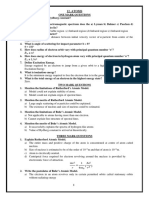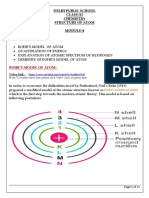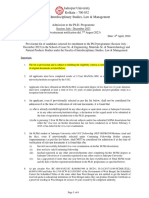Atomic Structure
1. Write down the Postulates of Rutherford’s atomic model.
Postulates of Rutherford’s atomic model :
1. Almost entire mass of atom and the entire positive charges of an atom are
concentrated in a very small region named as nucleus of the atom.
2. The size of nucleus is extremely small as compared to size of atom.
3. The negatively charged particles known as electrons revolves around the
nucleus. So most of the space in an atom is empty. The centripetal force required
for revolving the electrons around nucleus is provided by coulomb’s force of
attraction between nucleus and electrons.
4. The total negative charge of electrons surrounding the nucleus is equal to total
positive charge on the nucleus.
2. Write down the limitation /drawbacks of Rutherford's atomic model.
Drawbacks of Rutherford's atomic model:
(1) The orbital of the electron is not expected to be stable.
(2) According to Rutherford's model, electrons while moving in their orbit would
give up energy. This would make them slow down gradually and move towards the
nucleus. Electron will follow a spiral path and then fall into the nucleus. Ultimately
the atom would collapse. But in reality the atom is stable.
1
�3. Write down the Postulates of Bohr’s Atomic Model.
Postulates of Bohr’s Atomic Model are:
1. Electrons revolves around the nucleus in circular path. There is a type of
attractive force which holds electron and nucleus together. This attractive
force is equal to centripetal or electrostatic force(i.e.Columb’s force).
Numerically,
F=mv2/r
2. Electrons can only revolve in certain discrete orbit and orbits with non-
radiating energy. Non-radiating energy orbits are also called as stationary
orbits. The angular momentum of orbits should be equal to an integral
multiple of h/2π.
Numericlly,
mvr=nh/2π
3. The energy levels are represented by an integer (n=1, 2, 3…) known as
the quantum number. The orbits n=1, 2, 3, 4… are assigned as K, L, M,
N…. shells and when an electron attains the lowest energy level, it is said to
be in the ground state.
4. The electrons in an atom jumps from a lower energy level(E 1) to a higher
(E2) energy level by absorbing the required energy and an electron jumps
from a higher energy level to lower energy level by emitting energy. This
difference in energy is radiated or absorbed in the form of electromagnetic
radiation with frequency 'v'.
i.e E2-E1= hv
where,
2
� h = Planck's constant
v = frequency
This is called quantization of energy.
4. Write down the limitations of Bohr’s Atomic Model.
Limitation of Bohr’s theory:
1. It is only applicable to mono- electronic elements. i.e. It is only applicable to
elements containing only one electron such as Hydrogen atom.
2. It is unable to explain the splitting of lines in the magnetic field. In magnetic
field Zeeman effect is seen while in electric field Stark effect is seen. This
theory is unable to explain these splitting lines.
3. It is unable to explain the 3-dimensional model of atom.
4. It is also unable to explain the shape of molecules.
5. It does not obey the de-Broglie and Heisenberg uncertainty principle.
5.Write down Planck’s quantum theory.
According to Planck’s quantum theory,
1. Different atoms and molecules can emit or absorb energy in discrete
quantities only. The smallest amount of energy that can be emitted or
absorbed in the form of electromagnetic radiation is known as quantum.
2. The energy of the radiation absorbed or emitted is directly proportional to
the frequency of the radiation.
3
�Meanwhile, the energy of radiation is expressed in terms of frequency as,
E = h ν = hc/
Where,
E = Energy of the radiation
h = Planck’s constant (6.626×10–34 J.s)
ν= Frequency of radiation
6. What is hydrogen spectrum?
When an electric current is passed through a gaseous hydrogen molecule, the
hydrogen molecules dissociate. The H atoms get excited by this high power
and possess an energy that emits electromagnetic radiation of discrete
frequencies which forms hydrogen spectrum.
[The spectrum of hydrogen thus consists of five series of lines - for example,
the Lyman series, Balmer series, Paschen series, Brackett series and Pfund
series.
When a hydrogen atom absorbs a photon, it causes the electron to experience
a transition to a higher energy level, for example, n = 1, n = 2. When a
photon is emitted through a hydrogen atom, the electron undergoes a
transition from a higher energy level to a lower, for example, n = 3, n = 2.
During this transition from a higher level to a lower level, there is the
transmission of light occurs. The quantized energy levels of the atoms, cause
the spectrum to comprise wavelengths that reflect the differences in these
4
� energy levels. For example, the line at 656 nm corresponds to the transition
n = 3 n = 2.]
7. Derive an expression for the radius of any orbit in the hydrogen atom.
Ans: Let us consider, an electron of charge ‘e’ revolving around a nucleus of
charge ze, where z is the atomic number and e is the charge on a proton. Let ‘m’ be
the mass of electron, r is the radius of orbit and v is the velocity of the revolving
electron.
According to the coulomb’s law, the electrostatic force of attraction between the
nucleus and the electron,
𝐹 = 𝑧𝑒 𝑒 /r2
= ze2/r2…………………(1)
The centrifugal force acting on the electron,
F=mv2/r …………………..(2)
From equation (1) and (2) we get
ze2/r2 = mv2/r
or, ze2/r = mv2………………..(3)
5
�From Bohr’s atomic model, we know that
mvr = nh/2
or, v = nh/2mr
or, v2= n2h2/42m2r2
Putting the value of v2in equation (3)
ze2/r = mv2
or, ze2/r = m n2h2/42m2r2
or, ze2= n2h2/42mr
or, r = n2h2/42m ze2
For H, rn = o.529 x 10-8 x n2
For, He, rn = o.529 x 10-8 x n2 / 2
8. Rydberg formula
The Rydberg Formula applicable to the spectra of the different elements and is it
is expressed as
V=1/λ = RH (1/n12 - 1/n22)
where
where λ is the photon's wavelength (wavenumber = 1/wavelength)
R equals to Rydberg’s constant having a value of 1.0973731568539(55) x 10 7 m-1
Z is the atomic number of the atom and
n1 and n2 are integers, and n2 is greater than n1.
Spectral series Value of n1 Value of n2 Spectral region
Lyman series 1 2,3,4,5….. Ultra-violet region
Balmer series 2 3,4,5,6….. Visible region
6
� Paschen series 3 4,5,6,7,…… Infra-red region
Brackett series 4 5,6,7,8,…. Infra-red region
Pfund series 5 6,7,8,9,…… Infra-red region
9. Find the wavelength of the electromagnetic radiation that is emitted
from an electron relaxes from n = 3 to n = 1.
Solution: We have the Rydberg equation:
V=1/λ = RH (1/n12 - 1/n22)
Now put the known vakues,
n1 = 1
and n2 = 3.
RH = 1.9074 ×107m−1.
1/λ = RH(1/n12 −1/n22)
= 1.0947×107(1/12−1/32)
= 1.0947×107×8/9
= 0.973×107
λ=1.025×10−7meter
10. State and explain Hund’s Rule for nitrogen atom.
Hund’s rule states that:
1. In a sublevel, each orbital is singly occupied before it is doubly occupied.
2. The electrons present in singly occupied orbitals possess identical spin.
Consider the correct electron configuration of the nitrogen (Z = 7) atom:
1s2 2s2 2p3
7
�The p orbitals are half-filled; there are three electrons and three p orbitals. This is
because the three electrons having same spin in the 2p subshell will fill all the
empty orbitals first before pairing with electrons in them.
11. State and explain Pauli Exclusion Principle.
The Pauli exclusion principle states that:
Only two electrons can occupy the same orbital.
The two electrons that are present in the same orbital must have opposite spins,
or they should be antiparallel.
According to the Pauli exclusion principle ,for beryllium atom, the 1 s and 2s
subshells for beryllium atoms can hold only two electrons and when filled, the
electrons must have opposite spins.
12. State and explain The Aufbau principle with the example electronic
arrangement of K atom.
Ans: The Aufbau principle states that electrons fill atomic orbitals starting from the
lowest energy level before moving to higher levels.
For potassium (K), with 19 electrons, the Aufbau principle leads to the electron
configuration 1s²2s²2p⁶3s²3p⁶4s¹. This means the first two electrons go into the 1s
orbital, the next two into the 2s, then six into the 2p, two into the 3s, six into the
3p, and finally one into the 4s orbital. This filling order is based on increasing energy
8
�levels, with the 4s orbital being lower in energy than the 3d orbital, even though it's
in a higher energy level.
13. Describe the significance of four quantum numbers. Give the values
of the quantum numbers associated with the following orbitals: i.
3d, ii. 2p, iii. 4f.
Ans. There are four quantum numbers. These are Principal Quantum Number (n),
Azimuthal or Angular Momentum Quantum Number (l), . Magnetic Quantum Number
(ml) and Spin Quantum Number (ms).
Here's a breakdown of each quantum number:
1. Principal Quantum Number (n):
This number defines the electron's energy level and the size of its orbital. Higher
values of 'n' indicate higher energy levels and larger orbitals, meaning the electron is
further from the nucleus.
2. Azimuthal or Angular Momentum Quantum Number (l):
This number describes the shape of the electron's orbital and can have values from
0 to n-1. l = 0 corresponds to a spherical s orbital, l = 1 to a dumbbell-shaped p
orbital, l = 2 to more complex d orbitals, and so on.
3. Magnetic Quantum Number (m):
This number specifies the orientation of the orbital. It can take integer values from -l
to +l, including 0. For example, if l=1, m can be -1, 0, or +1.
4. Spin Quantum Number (s):
This is the angular momentum of the electron, also known as its spin. Electrons
behave as if they are spinning, creating a magnetic field, and they can only spin in
two directions, represented by s = +1/2 (spin up) and ms = -1/2 (spin down).
For a 3d orbital, the quantum numbers are: n=3, l=2, and m can be -2, -1, 0, 1, or
2. The spin quantum number (s) can be +1/2 or -1/2.
For a 2p orbital, the quantum numbers are: n=2, l=1, and m can be -1, 0, or
+1. The spin quantum number, s, can be +1/2 or -1/2.
For a 4f orbital, the quantum numbers are: n=4, l=3, ml = -3, -2, -1, 0, +1, +2, or
+3, and s = +1/2 or -1/2.
9
�10




















































































